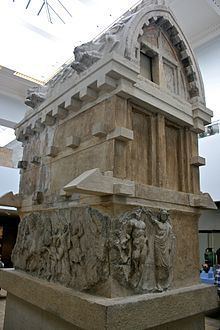Material Stone | Completion date 361 BC | |
 | ||
Height 3.5 metres (11 ft), originally 7.85 metres (25.8 ft) | ||
Tomb of payava top 5 facts
The Tomb of Payava is a Lycian tall rectangular free-standing barrel-vaulted stone sarcophagus built for Payava who was probably the ruler of Xanthos, Lycia (now Günük, Turkey) in around 360 BC. The tomb was discovered in 1838 and brought to England in 1844 by the explorer Sir Charles Fellows. He described it as a 'Gothic-formed Horse Tomb'.
Payava, who is named in the inscriptions, is only known from this tomb. The tomb is a particularly fine example of a common Lycian style, carved from stone but accurately depicting a wooden structure. The carved friezes on the tomb and its roof contain Greek and Persian features, showing the mix of influences in Xanthos at that time and show:
Three of the four tiers of the tomb are currently housed in the British Museum where they dominate the centre of room 20, the lowest tier was left in Turkey and is in a poor state. Displayed with the tomb are other Greek and Lycian objects from 400–325 BC.
